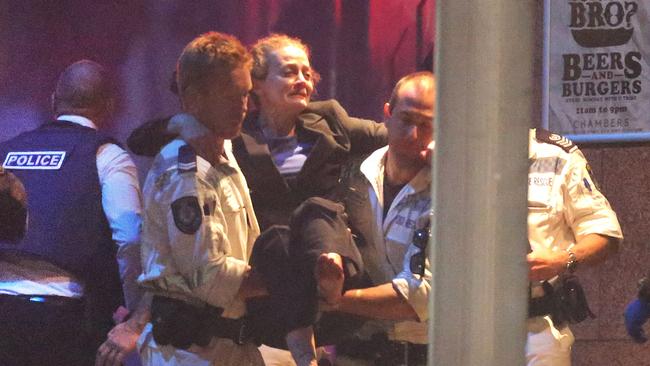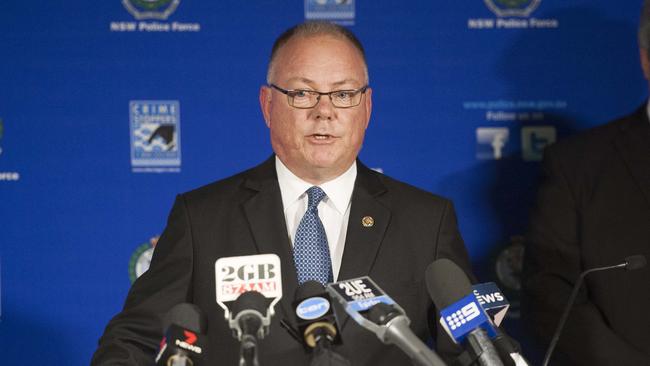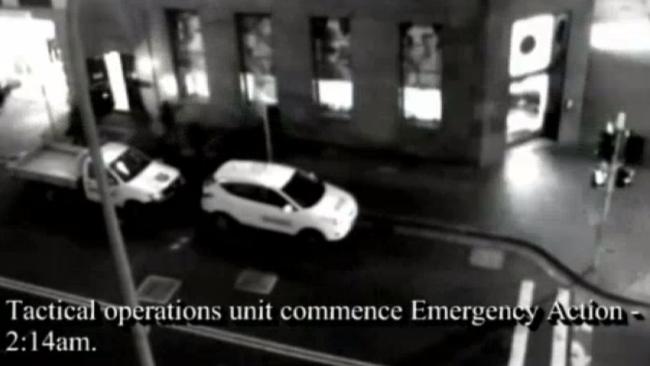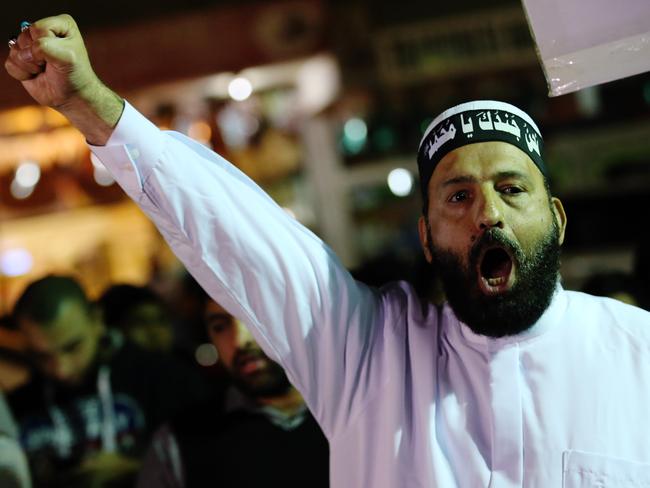Lindt Cafe siege inquest: Police assistant commissioner Mark Jenkins faces tough questions
POLICE assistant commissioner Mark Jenkins faces tough questions at the inquest into the deadly Lindt Cafe siege.

NSW
Don't miss out on the headlines from NSW. Followed categories will be added to My News.
IT WAS always going to be the elephant in the room for NSW Police Assistant Commissioner Mark Jenkins.
Why put him in command of bringing the country’s first terrorist siege to a peaceful end when he had botched the arrest of a notorious terrorist in the past in a misjudgment that led to both a police officer and an offender being shot?
In the end, it was the lawyer for the family of slain Lindt Cafe manager Tori Johnson who raised it this week at the inquest into the deadly 2014 siege.


The words of Gabrielle Bashir SC were brutal but to the point when she asked Jenkins: “You have had managerial counselling as a result of communications issues that arose in an earlier critical incident involving a terrorist wearing a backpack who shot at police officers?”
Jenkins: “Yes.”
Bashir: “You did not mention that to the coroner in your half-hour going through your medals and experience (at the start of giving evidence), did you?”
Jenkins: “No I didn’t.”
In the glare of the witness box, Jenkins denied he had “misjudged the level of a risk of a terrorist incident before”.
Jenkins is a veteran officer, a Harley-Davidson-riding supporter of the Homicide Victims Support Group. He rose to prominence during the arrest and conviction of Phuong Ngo for ordering the assassination of his Labor Party rival, Cabramatta MP John Newman, in 1994.
Some Ngo supporters gave Jenkins the nickname “Robocop”, referring to his rigid posture and apparent lack of emotion.

He had been head of State Crime Command for 21 months when Man Monis walked into the Lindt Cafe on the morning of December 15, declaring a siege on behalf of Islamic State, taking 18 hostages.
It has emerged at the inquest that when Jenkins took over as commander of siege management about 9.30 that night, negotiation had reached stalemate, with Monis refusing to talk directly to police negotiators.
Police continued to pursue their policy of contain and negotiate, while their strategy was that a hostage had to die or be seriously injured before the emergency action (EA) plan to storm the cafe would be automatically triggered.
As head of the Police Operations Centre, Jenkins told the inquest his job was strategic. The head of the FOC — or Forward Operations Command — positioned closer to the cafe had the tactical role and the responsibility to order the EA.
That commander, who cannot be identified, has not yet given evidence.
So that was the situation with Jenkins, in overall charge at 2.03am on December 16, when six hostages escaped and Monis fired his sawn-off shotgun for the first time.
Monis was wearing a black backpack in which he claimed he had a bomb. It was believed the bomb was big enough to kill everyone in the cafe.
THE PAST
BACKTRACK nine years to 2005 and another terrorist wearing another black backpack in which it was not known whether he had a bomb.
Jenkins was boss of the state’s Counter Terrorism Co-ordination Command as the country’s largest ever counter-terrorism operation, Operation Pendennis, swung into action with 16 terrorists arrested in Sydney and Melbourne. Among those netted was Khaled Sharrouf, who, after serving his sentence, joined Islamic State, allowing his young son to pose with the heads of Syrian soldiers. Sharrouf is now believed to be dead.
On November 8, 2005, Jenkins directed four officers to arrest the one outstanding Pendennis target, Omar Baladjam. Baladjam pulled out a gun. One officer was shot in the hand. Baladjam was shot in the neck.

Jenkins was found by an internal police report to have “failed in the duty of care’’ by not “adequately warning’’ the four officers and putting their lives at risk. The review found he had failed to tell them Baladjam was violent, often armed and a member of a known terrorist cell.
None of the four arresting officers was wearing a bulletproof vest.
In the end, no bomb was found in Baladjam’s backpack but only after a bomb-disposal robot was used to check it.
Deputy Commissioner Cath Burn, then commander of Professional Standards Command, chaired the panel that recommended Jenkins be counselled.
“It’s a fact you failed to appreciate the risk of dangerousness previously?” Bashir put to Jenkins at the inquest on Wednesday in a fiery exchange.
Jenkins: “I don’t believe that to be the case.”
Bashir: “And you failed to do so in the early hours of December 16?”
Jenkins: “No, I don’t accept that at all.”
THE SIEGE
THOSE crucial final moments of the early hours of December 16 were marred by an apparent series of communication stuff-ups, according to evidence given to the inquest this week.
Jenkins said he had not been told of a text received by police at 1.53pm. It had been sent by Johnson to his family about the danger level rising in the cafe.
“He’s (Monis) becoming increasingly agitated. Walks around when he hears noises outside with a hostage in front of him. Wants to release a person in good faith. Tell police.”
At 1.59am, Jenkins was standing at the door of the office of the officer known as Tactical Adviser.
He was giving the go-ahead to give in to a demand from Monis made through hostage Selina Win Pe for all the lights in Martin Place to be turned off — in return for the release of a female hostage.

He said he felt optimistic and thought things were looking more positive.
Then the six hostages fled and the shot rang out at 2.03am.
While the FOC commander has yet to state what he was told, Jenkins has said he himself was never told the shot had been believed to be towards the hostages.
He did not know of at least three notes from hostage debriefings to that effect between 2.05am and 2.10am.
Jenkins said his “construct” from what he was told was that Monis had been deliberately firing to miss the hostages, perhaps to lure police into the cafe. This was not enough to trigger the EA.
Jenkins wasn’t told that, at 2.06am, Tori Johnson was forced to his knees in the cafe. Nor was he told that at 2.09am Monis fired a second shot. Jenkins said he would have expected the FOC commander to be given those alerts.
At 2.13am, the EA was triggered and the cafe stormed when Monis shot Johnson dead. Barrister Katrina Dawson died after being hit by police bullet fragments during the bloody climax.

UK terrorism experts consulted by the inquest are “unequivocal” that police should have ended it after Monis fired the first time.
NSW counter-terrorism chief Mark Murdoch broke ranks to declare he, too, would have expected officers to enter the cafe after the first shot.
Jenkins said this week that he didn’t agree with his colleague: “Mr Murdoch was not there ... I don’t agree with his proposition.”
There was a third option to the strategies of an EA plan of control and negotiate — direct action. It entailed being proactive and forcing entry at the time of police choosing but while Tactical Operations Unit officers supported raiding the cafe under the DA, it was ruled out.
Jenkins has denied he was given an order or even a “suggestion” by Commissioner Andrew Scipione that the direct action was to be a “last resort”.
THE PRESENT
IT was Jenkins’s second appearance at the inquest.
Last year he was called to explain why he did not send a letter drafted by frustrated homicide detectives to ask the Director of Public Prosecutions Lloyd Babb SC to review a decision in Penrith Local Court in December 2013 to free Monis on bail on a charge of being an accessory to murder.
Jenkins said he never sent the letter because he formed the view, after discussions with homicide chief Superintendent Mick Willing, that the review “was not likely to be successful”.
Willing had already told the inquest they believed that getting the DPP to review the bail was like “pushing shit uphill”.
Jenkins told the inquest last year that, with hindsight, he would done things differently. If he had known what Monis would do a year later, he would have personally taken that letter to the DPP and sat and waited until a bail review was initiated.
This week he said that had he known that the shot fired by Monis at 2.03am was fired directly at the hostages — and only missed because Monis was a bad shot — he would have considered that police should have activated the EA plan then and not waited the extra 10 minutes.
The final responsibility was however not his.
It was the responsibility of the commander at the FOC, he said.


